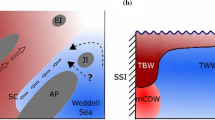Synopsis
Direct underwater observations of myctophid fishes were conducted to 630 m in submarine canyons along the outer margin of the northeast United States continental shelf with the Johnson-Sea-Link II submersible. Data revealed that myctophids occurred in aggregations of other pelagic fauna (e.g., ctenophores, sergestids, amphipods) when densities of the former were low but the latter were high. We suggest that myctophids selectively occur with other pelagic fauna to reduce the probability of direct contact with predators and to take advantage of aggregate search abilities for common prey taxa.
Similar content being viewed by others
References cited
Anderson, E. 1974. Trophic interactions among ctenophores and copepods in St. Margaret's Bay, Nova Scotia. Ph.D. Thesis, Dalhousie University, Halifax. 85 pp.
Backus, R.H., J.E. Craddock, R.L. Haedrich & D.L. Shores. 1970. The distribution of mesopelagic fishes in the equatorial and western North Atlantic Ocean. J. Mar. Res. 28: 179–201.
Backus, R.H., J.E. Craddock, R.L. Haedrich & B.H. Robison. 1977. Atlantic mesopelagic zoogeography. pp. 266–287. In: R.H. Gibbs, Jr. (ed.) Fishes of the Western North Atlantic, Sears Found. Mar. Res., Yale Univ., Mem. 1, Pt. 7.
Badcock, J. & N.R. Merrett. 1976. Midwater fishes in the eastern North Atlantic-I. Vertical distribution and associated biology in 30° N, 23° W, with developmental notes on certain myctophids. Prog. Oceanogr. 7: 3–58.
Barham, E.G. 1963. Siphonophores and the deep scattering layer. Science 140: 826–828.
Barham, E.G. 1966. Deep scattering layer migration and composition: observations from a diving saucer. Science 151: 1399–1403.
Beebe, W. 1935. Half mile down. Duell, Sloan and Pearce, New York. 344 pp.
Brock, V.E. & R.H. Riffenburgh. 1960. Fish schooling: a possible factor in reducing predation. J. du Cons. 25: 307–317.
Clarke, T.A. 1973. Some aspects of the ecology of lanternfishes (Myctophidae) in the Pacific Ocean near Hawaii. U.S. Fish. Bull. 71: 401–434.
Deason, E.E. & T.J. Smayda. 1982. Ctenophore-zooplanktonphytoplankton interactions in Narragansett Bay, Rhode Island, USA, during 1972–1977. J. Plank. Res. 4: 203–217.
Ehrlich, P.R. & A.H. Ehrlich. 1973. Coevolution: heterotypic schooling in Caribbean reef fishes. Amer. Nat. 107: 157–160.
Foxton, P. & H.S.J. Roe. 1974. Observations on the nocturnal feeding of some mesopelagic decapod crustacea. Mar. Biol. 28: 37–49.
Frank, K.T. & W.C. Leggett. 1982. Coastal water mass replacement: its effect on zooplankton dynamics and the predator-prey complex associated with larval capelin (Mallotus villosus). Can. J. Fish. Aquat. Sci. 39: 991–1003.
Gartner, J.V. Jr., T.L. Hopkins, R.C. Baird & D.M. Milliken. 1987. The lanternfishes (Pisces: Myctophidae) of the eastern Gulf of Mexico. U.S. Fish. Bull. 85: 81–98.
Gjosaeter, J. 1973. Age, growth and mortality of the myctophid fish, Benthosema glaciale (Reinhardt), from western Norway. Sarsia 52: 1–14.
Gjosaeter, J. & K. Kawaguchi. 1980. A review of the world resources of mesopelagic fish. FAO Fish. Tech. Pap. No. 193. 151 pp.
Halliday, R.G. 1970. Growth and vertical distribution of the glacier lanternfish, Benthosema glaciale, in the northwestern Atlantic. J. Fish. Res. Board Can. 27: 105–116.
Jahn, A.E. & R.H. Backus. 1976. On the mesopelagic fish fauna of slope water, Gulf Stream, and northern Sargasso Sea. Deep-Sea Res. 23: 223–234.
Keenleyside, M.H.A. 1979. Diversity and adaptation in fish behavior. Zoophysiol. Ecol. 11: 1–208.
Mackie, G.O. & C.E. Mills. 1983. Use of the Pisces IV submersible for zooplankton studies in coastal waters of British Columbia. Can. J. Fish. Aquat. Sci. 40: 763–776.
Milliman, J.D. & F.T. Manheim. 1968. Observations in deep-scattering layers off Cape Hatteras, U.S.A. Deep-Sea Res. 15: 505–507.
Morse, D. 1977. Feeding behavior and predator avoidance in heterospecific groups. BioScience 27: 332–339.
Neill, S.R.St.J. & J.M. Cullen. 1974. Experiments on whether schooling by their prey affects the hunting behaviour of cephalopod and fish predators. J. Zool. Lond. 172: 549–569.
Nelson, J.S. 1984. Fishes of the world. John Wiley & Sons, New York. 523 pp.
Nursall, J.R. & M.E. Pinsent. 1969. Aggregations of spottail shinners and yellow perch. J. Fish. Res. Board Can. 26: 1672–1676.
Ogden, J.C. & P.R. Ehrlich. 1977. The behavior of heterotypic resting schools of juvenile grunts (Pomadasyidae). Mar. Biol. 42: 273–280.
Omori, M. 1974. The biology of pelagic shrimps in the ocean. Adv. mar. Biol. 12: 233–234.
Pitcher, T.J. 1986. Functions of shoaling behaviour in teleosts. pp. 294–337. In: T.J. Pitcher (ed.) The Behavior of Teleost Fishes, The Johns Hopkins University Press, Baltimore.
Pitcher, T.J., A.E. Magurran & I.J. Winfield. 1982. Fish in larger shoals find food faster. Behav. Ecol. Sociobiol. 10: 149–151.
Robison, B.H. 1983. Midwater biological research with the WASP ADS. Mar. Tech. Soc. J. 17 (3): 21–27.
Roe, H.S.J. & J. Badcock. 1984. The diel migrations and distributions within a mesopelagic community in the North East Atlantic. 5. Vertical migrations and feeding of fish. Prog. Oceanog. 13: 389–424.
Sameoto, D.D. 1982. Zooplankton and micronekton abundance in acoustic scattering layers on the Nova Scotia slope. Can. J. Fish. Aquat. Sci. 39: 760–777.
Sameoto, D.D. 1988. Feeding of the lantern fish Benthosema glaciale off the Nova Scotia shelf. Mar. Ecol. Prog. Ser. 44: 113–129.
Sheader, M. & F. Evans. 1975. Feeding and gut structure of Parathemisto gaudichaudi (Guerin) (Amphipoda, Hyperiidea). J. Mar. Biol. Ass. U.K. 55: 641–656.
Tyler, H.R. Jr. & W.G. Pearcy. 1975. The feeding habits of three species of lanternfishes (family Myctophidae) off Oregon, USA. Mar. Biol. 32: 7–11.
Willis, J.M. & W.G. Pearcy. 1980. Spatial and temporal variations in the population size structure of three lanternfishes (Myctophidae) off Oregon, USA. Mar. Biol. 57: 181–191.
Youngbluth, M.J. 1984. Manned submersibles and sophisticated instrumentation: tools for oceanographic research. pp. 335–344. In: Proceedings of SUBTECH 1983 Symposium, Soc. Underwater Tech., London.
Author information
Authors and Affiliations
Rights and permissions
About this article
Cite this article
Auster, P.J., Griswold, C.A., Youngbluth, M.J. et al. Aggregations of myctophid fishes with other pelagic fauna. Environ Biol Fish 35, 133–139 (1992). https://doi.org/10.1007/BF00002187
Received:
Accepted:
Issue Date:
DOI: https://doi.org/10.1007/BF00002187




